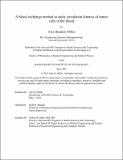A blood exchange method to study circulation kinetics of tumor cells in the blood
Author(s)
Miller, Alex Brandon
DownloadThesis PDF (16.68Mb)
Advisor
Manalis, Scott R.
Terms of use
Metadata
Show full item recordAbstract
Blood is an essential compartment for tumor cell trafficking. In solid epithelial-derived tumors, blood serves as the major vehicle for metastasis, whose principal cell is the circulating tumor cell (CTC). These cells originate from the primary tumor and are shed at low concentrations into the blood, where they travel to distant sites to initiate metastatic lesions. In liquid, blood-borne cancers, the blood is a major reservoir of disease, and allows cells to move between the bone marrow, where disease typically initiates, to other sites throughout the body.
While the general steps of these processes is known, there is a lack of evidence in the field regarding the physical properties defining tumor cell trafficking through the blood. Several studies have estimated vastly conflicting half-life time of CTCs, ranging from seconds to hours. However, these studies are limited in that they typically involve monitoring the decay in concentration of injected in vitro cultured cells, rather than that of native, unprocessed tumor cells. Measuring the blood concentration of these injected in vitro cultured cells over time is insufficient to extrapolate the two defining variables which underlie the concentration of CTCs: half-life time and generation rate. Studying these parameters is crucial to understanding the nature of the metastasis of cancer throughout the body, which remains the leading cause of cancer deaths.
Our lab has developed a technology capable of detecting genetically fluorescent CTCs longitudinally directly from the bloodstream of mice in real-time. The system combines a surgical cannulation technique of the jugular vein and carotid artery with a lab-built optofluidic platform, which uses laser-based detection on a microfluidic chip, to enumerate and capture CTCs from un-anesthetized mice. By setting two of these in sequence, we aim to develop a method for transferring unprocessed CTC-containing blood between animals and monitoring the resulting blood concentrations to elucidate the circulatory kinetics of tumor cells in the blood.
In this thesis, we begin by developing a system to determine circulation properties of CTCs. Using a series of real-time CTC detection platforms, we create a model to describe how the exchange of blood between healthy and tumor-bearing mice allows us to extrapolate circulation properties of the cells. Next, we apply this platform to study the circulation kinetics of CTCs from several models of solid-tumor disease. Finally, we use these techniques to study the kinetics of leukemia cells. By varying the tumor and treatment status of donor and recipient animals, we assess how the tumor cells themselves and the microenvironment of the bone marrow impacts tumor cell clearance. We discover that E-selectin, a vascular adhesion molecule, prevents cell turnover between tumor compartments and enables relapse cells to escape circulation more quickly. Altogether, this work provides a novel method to assess circulation kinetics of tumor cells and identify features that regulate the clearance of tumor cells from the blood.
Date issued
2023-06Department
Harvard-MIT Program in Health Sciences and TechnologyPublisher
Massachusetts Institute of Technology